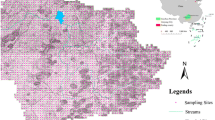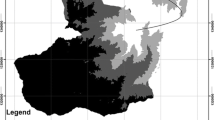Abstract
The paper respectively adopted physio-chemical properties of every soil stratum from 2473 soil profiles of the second national soil survey. The corresponding carbon content of soils is estimated by utilizing conversion coefficient 0.58. In the second soil survey, the total amount of soil organic carbon is about 924.18xl08t and carbon density is about 10.53 kgC/m2 in China according to the area of 877.63x106hm2 surveyed throughout the country. The spatial distribution characteristics of soil organic carbon in China is that the carbon storage increases when latitude increases in eastern China and the carbon storage decreases when longitude reduces in northern China. A transitional zone with great variation in carbon storage exists. Moreover, there is an increasing tendency of carbon density with decrease of latitude in western China. Soil circle is of great significance to global change, but with substantial difference in soil spatial distribution throughout the country. Because the structure of soil is inhomogeneous, it could bring some mistakes in estimating soil carbon reservoirs. It is necessary to farther resolve soil respiration and organic matter conversion and other questions by developing uniform and normal methods of measurement and sampling.
Similar content being viewed by others
References
Post W M, Peng T H, Emanuel W Ret al. The global carbon cycle.American Scientist, 1990, 78: 310–326.
Houghton R A, Skole D L. Carbon. In: Kates R Wet al. The Earth As Transformed By Human Action Turner B L, Clark W C, Kates R W, Richards J F, Mathews J T, Meyer W B. Cambridge: Cambridge University Press, 1990. 393–408.
Wang Y, Chen Z, Larry T T. Distribution of soil organic carbon in the major grasslands of Xilin Gol, Inner Mongolia, China.Acta Phytoecologica Sinica, 1998,22(6): 545–551.
Wang Q, Li L, Liu X, He J. Spatial heterogeneity of soil organic carbon and total nitrogen in a Xilin River basin grassland, Inner Mongolia.Acta Phytoecologica Sinica, 1998,22(5): 409–414.
Post W M, Emanuel W R, Zinke P Jet al. Soil carbon reservoirs and life zones.Nature, 1982,298: 156–159.
Fang J, Liu G, Xu S. Carbon reservoir of terrestrial ecosystem in China. In: Monitoring and Relevant Process of Greenhouse Gas Concentration and Emission. Beijing: China Environmental Sciences Publishing House, 1996, 109–128.
Torn M S, Trunbore S E, Chadwick O Aet al. Mineral control of soil organic carbon storage and turnover.Nature, 1997,389: 170–173.
Jenkinson D S, Adams D E, Wild A. Model estimates of CO2 emissions from soil in response to global warming.Nature, 1991,351: 304–306.
Sampson R N, Apps M, Brown Set al. Terrestrial biosphere carbon fluxes quantification of sinks and sources of CO2.Water, Air and Soil Pollution, 1993,70: 3–15.
Li Z, Wang X. Simulation of soil organic carbon dynamic after changing landuse pattern in hilly red soil region.Chinese Journal of Applied Ecology, 1998,9(4): 365–37.
Li L. Effects of land-use change on soil carbon storage in grassland ecosystems.Acta Phytoecologica Sinica, 1998,22(4): 300–302.
Wu Z, Zeng Q, Li Yet al. A preliminary research on the carbon storage and CO2 release of the tropical forest soils in Jianfengling, Hainan Island, China.Acta Phytoecologica Sinica. 1997,21(5): 416–423.
Wu Z, Zeng Q, Li Yet al. Carbon reservoir of tropical mountain rain forests in Jianfengling and effect of clearcutting on it.Chinese Journal of Applied Ecology, 1998,9(4): 341–344.
Li Y, Wu Z, Zeng Qet al. Carbon reservoir and carbon dioxide dynamics of tropical mountain rain forest ecosystem at Jianfengling, Hainan Island.Acta Ecologica Sinica, 1998,18(4): 371–378.
Wang Y, Shen Q, Shi R. Changes of soil microbial biomass C, N and P and the N transformation after application of organic and inorganic fertilizers.Acta Pedologica Sinica, 1998,35(2): 227–234.
Li L, Liu X, Chen Z. Study on the carbon cycle ofLeymus chinensis steppe in the Xilin River basin.Acta Botanica Sinica. 1998,40(10): 955–961.
Xu D. The effect of human management activities on the carbon in forest soils.World Forestry Research, 1994,5: 26–31.
Liu S, Fang J, Makoto Kiyota. Soil respiration of mountainous temperate forests in Beijing, China.Acta Phytoecologica Sinica, 1998,22(2): 119–126.
Zhang L, Cao H, Gao Jet al. Effect of plant changes induced by elevated atmospheric CO2 on soil biota.Chinese Journal of Ecology, 1998,17(4): 33–38.
National Soil Survey Office. Chinese Soils. Beijing: China Agriculture Press, 1998. 1–1252.
National Soil Survey Office. Chinese Soil Cenus Records, Volumes 1–6. Beijing: China Agriculture Press, 1995.
Foley J A. An equilibrium model of the terrestrial carbon budget.Tellus, 1995,47B: 310–319.
Zhou C, Li B, Hao Y. The preliminary analysis of the transitional zone in Central China and its environmental features.Geographical Research, 1998,17 (supplement): 33–42.
Sombroek W G, Nachtergaele F O, Hebel A. Amount, dynamics and sequestering of carbon in tropical and subtropical soils.AMBIO, 1993,22(7): 417–426.
Prentice K C, Fung I Y. The sensitivity of terrestrial carbon storage to climate change.Nature, 1990,346: 48–51.
King A W, Emanuel W R, Wullschleger S Det al. A search of the missing carbon sink: a model of terrestrial biospheric response to land-use change and atmospheric CO2.Tellus, 1995,47B: 501–519.
Zhao Q. Significance and research scope of pedosphere in global changes.Earth Science Frontiers, 1997,4(2): 153–162.
Sven Sandström. Carbon storage and flow: their relationship to water, soil and land management.AMBIO, 1993,22(7): 438–441.
Sedjo R A. The carbon cycle and global forest ecosystem.Water, Air and Soil Pollution, 1993,70: 295–307.
Houghton R A, Hobbie J E, Melillo J Met al. Changes in the carbon content of terrestrial biota and soils between 1860 and 1980: a net release of CO2 to the atmosphere.Ecological Monographs, 1983,53(3): 235–262.
Houghton R A. Land-use change and the carbon cycle.Global Change Biology, 1995,1: 275–287.
Sandra Brown. Mitigation potential of carbon dioxide emissions by management of forests in Asia.AMBIO, 1996,25(4): 273–278.
Author information
Authors and Affiliations
Rights and permissions
About this article
Cite this article
Shao-qiang, W., Cheng-hu, Z., Ke-rang, L. et al. Estimation of soil organic carbon reservoir in China. J. Geogr. Sci. 11, 3–13 (2001). https://doi.org/10.1007/BF02837371
Received:
Accepted:
Issue Date:
DOI: https://doi.org/10.1007/BF02837371




